The Moon plays a vital role in everyday life, even if we don’t know it. The two biggest things the 4.53 billion-year-old rock dictates on Earth are the tide and time. The different phases of the moon have outlined what we termed as months, including the number of days in a month for a Lunar Calendar.
The Lunar Calendar for example is specifically a calendar that is based on the cycles of the moon. It’s estimated that the average time between two full moons is 29.5 days, therefore the months on the Lunar Calendar were made to be either 29 or 30 days.
A moon phase complication is one of the world’s oldest watch complications. The complication dates back to Ancient Greek times, where the earliest moon phase complication was found on the Antikythera Mechanism. This mechanism was developed by the Ancient Greeks to predict astronomical events, and it would show moon phases and eclipses.

In the modern world, when a moon phase complication is mentioned, one immediately thinks of wristwatches. The first moon phase complication on a wristwatch was developed by Patek Phillipe in 1925, which was shortly followed by Rolex with their own interpretation of the moon phase with Reference 8171 in 1949. In the 21st century, the moon phase complication can be found on timepieces ranging from entry-level to high-level luxury pieces. Most brands follow the same design of displaying the moon phase on the dial, however, a few brands have dared to step outside the norm and create incredible pieces that show this complication in a new light.
How does the moon phase complication work?
The most common way a moon phase is designed on a timepiece is by having two moons on a disc that rotates, shown through a half-circle aperture on the dial. This aperture would only show the correct phase of the moon depending on its current position on the Lunar cycle.
As mentioned earlier, the Lunar Cycle is approximately 29.5 days per month. To be accurate for a watch-making complication, however, the Lunar Cycle is taken as 29 days, 12 hours, 44 minutes, and 2.8 seconds. The hour wheel on the gear train plays a vital role in the operation of the moon phase. As the hour wheel makes one full rotation around the dial every 12 hours (on standard 12-hour timepieces), the hour wheel drives the moon wheel at a ratio of 1:2 (24hrs/2).
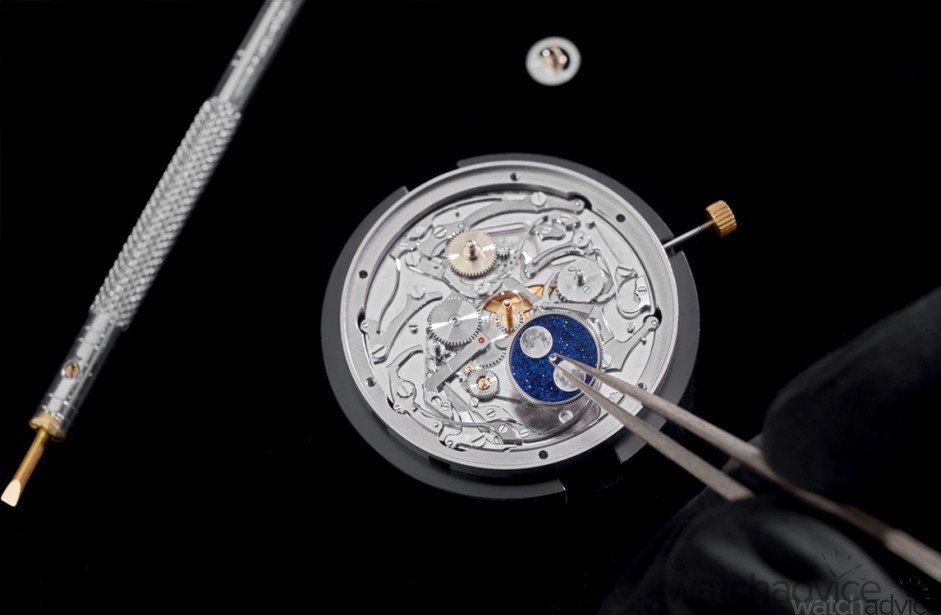
The standard moon disc will come with a one-tooth gear that is mounted co-axially. Hidden underneath the dial, the moon disc has 59 peripheral teeth, which results in the advancement of the moon disc once per day. The reason there are 59 teeth is because of the Lunar cycle. 59 divided by 2 is 29.5, which means one moon phase will end after 29.5 days. Having two moons on the moon disc means that when the cycle for the first one is finished, the disc automatically will display the Lunar cycle for the second disc, thereby having a continuous rotational moon phase.
A Moon phase can be displayed in many different ways on the dial. The most common is the half-circle aperture on the dial where the moon phase, the starry night sky along with clouds are shown. Below is a list of some of the different variations of moon phases shown on watch dials.

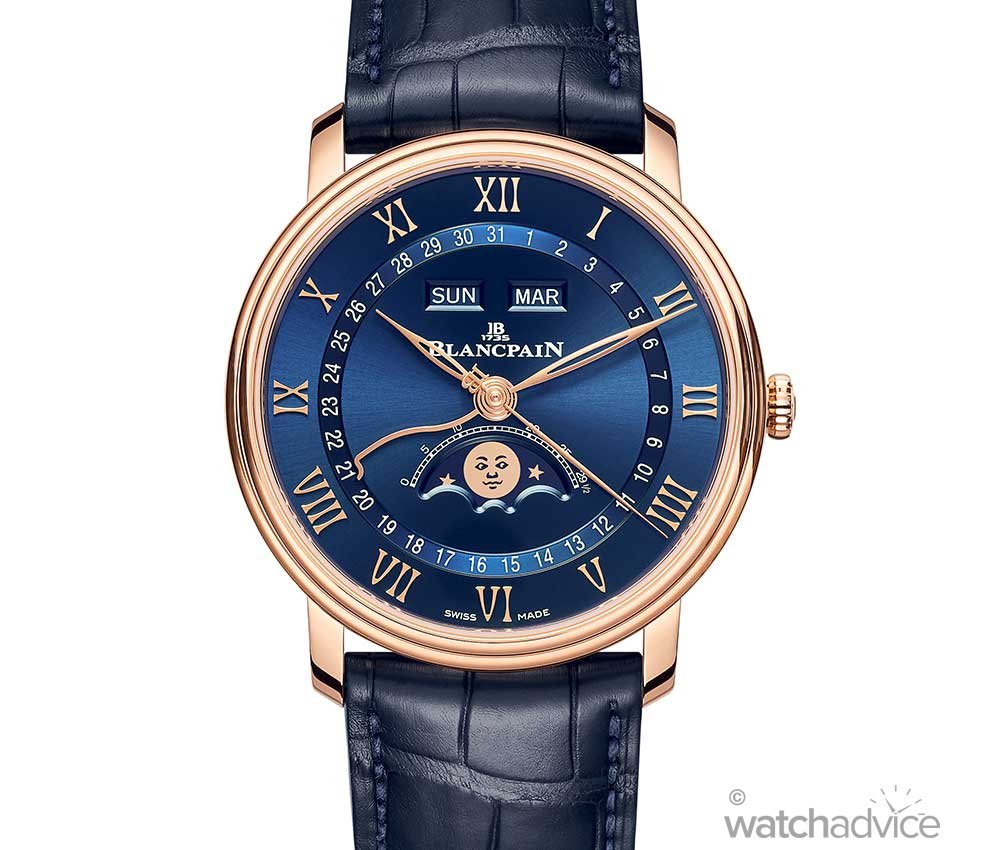
Blancpain Villeret Quatieme Complet Blue Dial
(Image ref: Watche-news.com/villeret-quatieme-complet-blue-dial)
This stunning display of horology combines red gold with a deep sky blue to make one aesthetic-looking watch. Everything about this timepiece was made to be as beautiful as possible, to complement the host of complications sitting underneath.
The Villeret Quatieme Complet Blue Dial comes with a standard moon phase aperture at 6 o’clock, where a graphic display of the moon and two stars are shown. The half aperture is designed to show the clouds covering the night sky and moon. Along the top half of the aperture, Blancpain has also shown the Lunar cycle of 29.5 days.

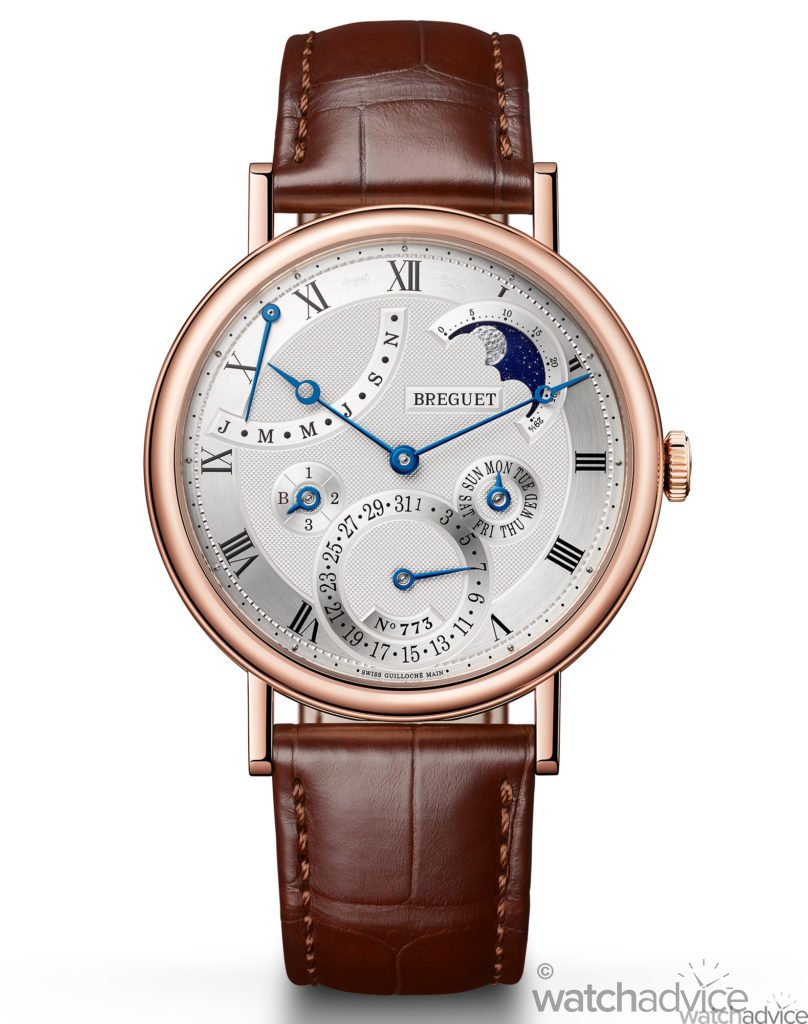
Breguet Classique Quantieme Perpetual 7327
Another beautiful display of functions on a dial is the updated Breguet Classique Quantieme Perpetual 7327. The successor to reference 5327 from Breguet, this dial is more refined, less cluttered, and also has an updated moon phase indicator.
The previous moon phase design for this Classique Quantieme Perpetual looked very similar to the Blancpain moon phase indicator above. For this latest reference, Breguet has chosen to go with an accurate depiction of the moon and starry night sky, combined with the aperture’s cloud design. Once again the Lunar Calendar cycle days can be found on the top of the aperture.
If you want to read more about the Breguet Classique Quantieme Perpetual 7327 and see more close-up pictures of that beautiful moon phase, click here!

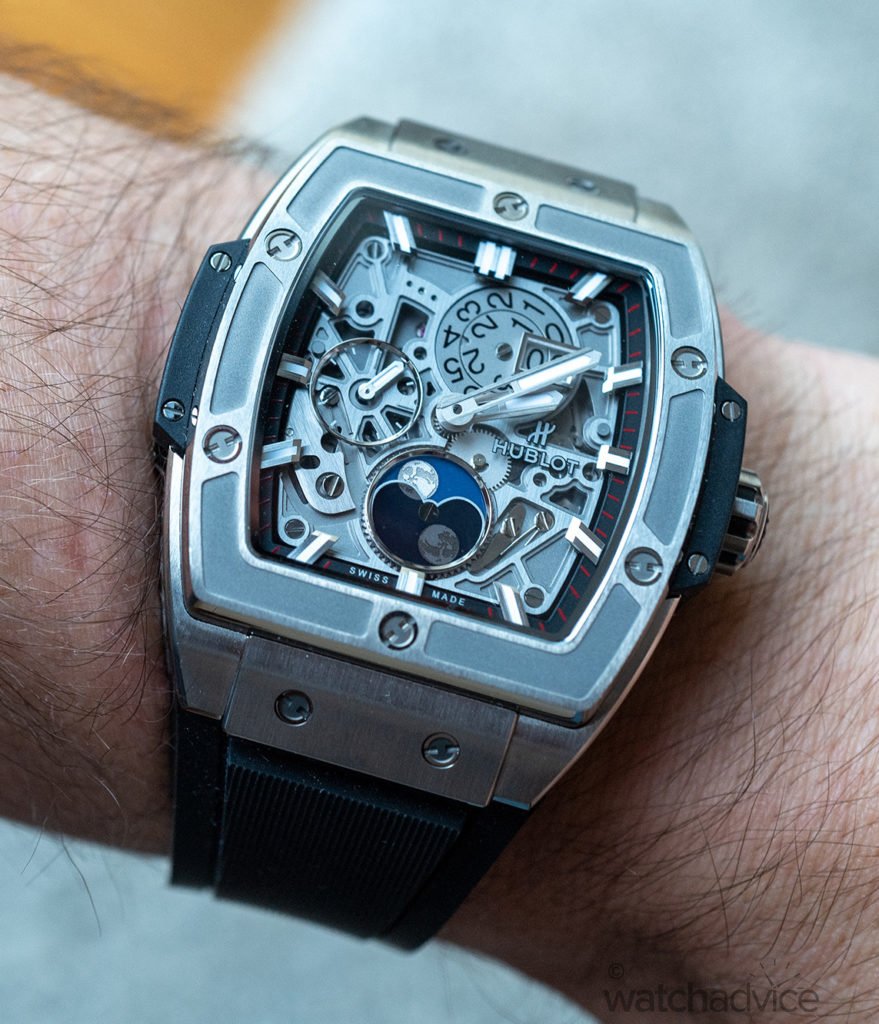
Hublot Spirit of Big Bang Moonphase Titanium Hands
This monochromatic timepiece is uplifted by the colourful moon phase display at 6 o’clock. The timepiece is full skeleton, where everything is stripped down to a bare minimum to show the movement and workings underneath.
The moon phase indicator follows suit. Although not fully skeletonised, the timepiece comes with a transparent aperture. This shows how the previously mentioned moon phase disc is operated, with two moons being displayed on the singular disc so that after one Lunar cycle ends the other begins in a continuous motion.
Want to see more of this skeletal masterpiece and a closer look at how the moon phase disc looks? Click here!


Christopher Ward C1 Moonglow
The C1 Moonglow by Christopher Ward gives a unique take on the moon phase indicator. The brand’s in-house moon phase movement tracks the moon’s orbit accurately for 128 years! There are two-three dimensional moons on the dial, coated with a generous amount of Grade X1 GL Super-LumiNova, which gives that incredible “moonglow” you see in the picture.
Rotating like a normal moon disc, now covering the whole dial, the phase of the moon can be read from an aperture at 12 o’clock, while the second moon remains “clouded” under smoked glass.

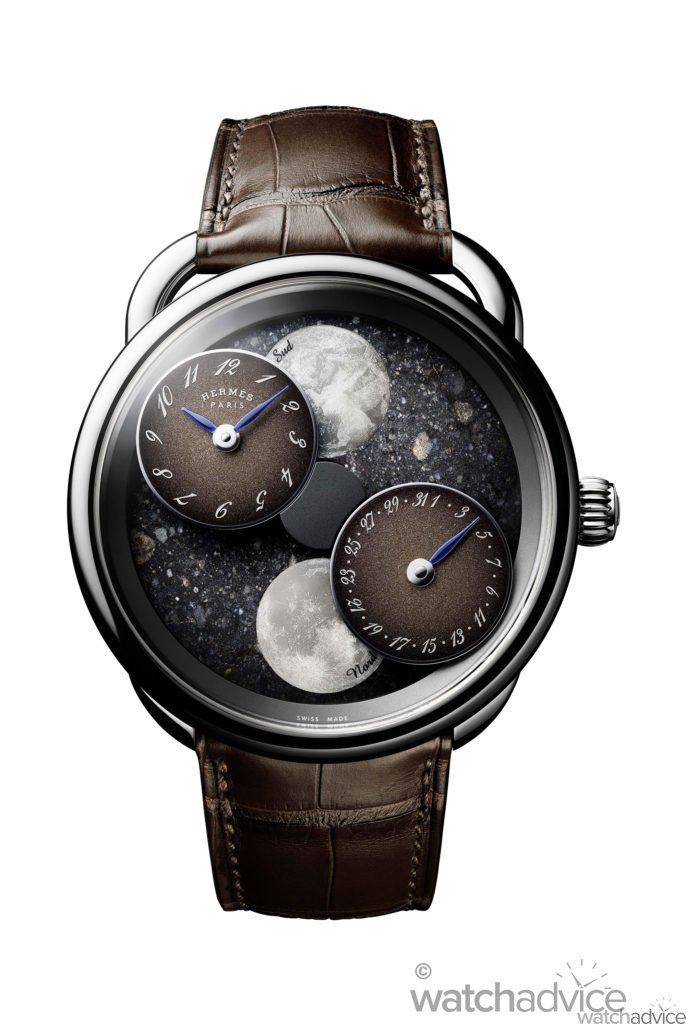
HERMÈS Arceau L’heure De La Lune
One of the most epic displays of a moon phase indicator we’ve seen is HERMÈS’s Arceau L’heure De La Lune. This is a dreamlike timepiece made for lovers of astronomy.
This very unique timepiece shows what Earth’s satellites see’s. It simultaneously displays the moon phases of both the northern and southern hemispheres. The phases of the moon are indicated by, you guessed it, the rotating sub-dials of the hour and date.
This awe-inspiring display of rocks, moon phases, and rotating subdials can be seen more in-depth in our article here!

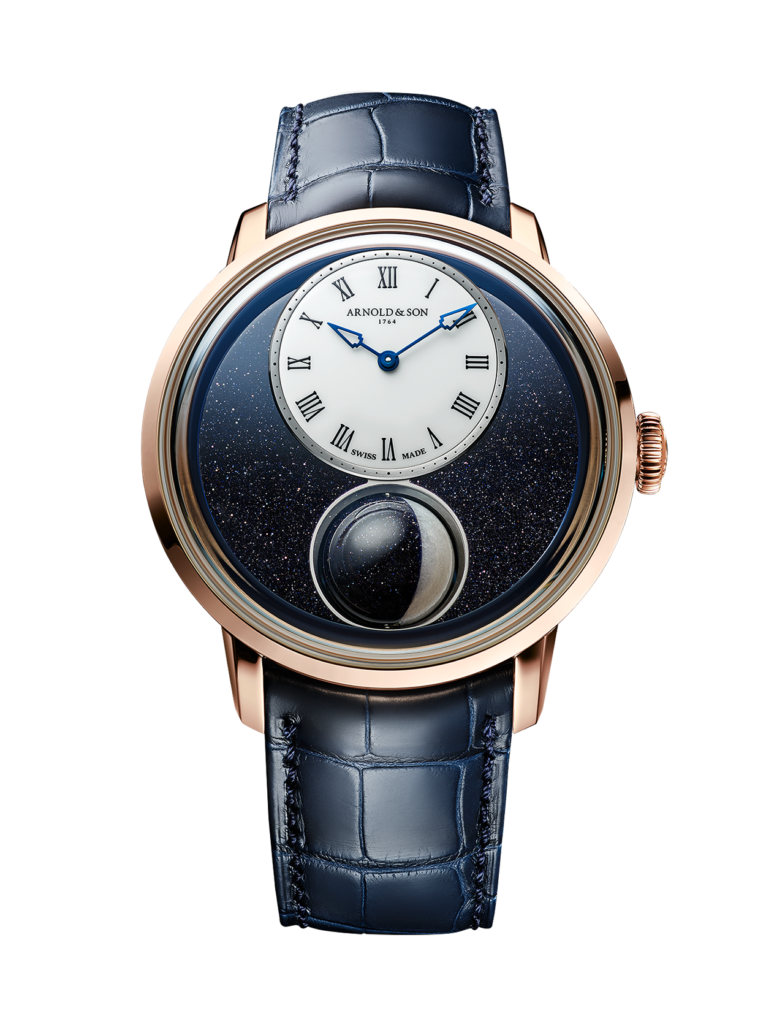
Arnold & Son Luna Magna Gold
The Arnold & Son Luna Magna Gold is a stunning display of a moon phase indicator. The timepiece focuses solely on the moon phase indicator, with even the main dial being offset to show more of the moon phase and the surrounding starry night sky.
This is the first-ever 3D moon phase indicator shown on a watch at this scale. Made of marble and aventurine, the moon showcases its different phases with astronomical precision. On the case back of the timepiece, is Arnold & Son’s incredible aesthetic design of the movement. At the center of the case back, the brand has placed a rotating sphere that accurately represents the appearance of the quarters of the moon against a starry backdrop.




